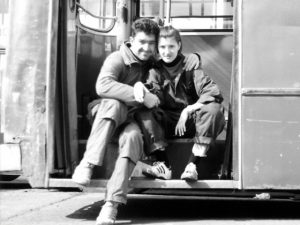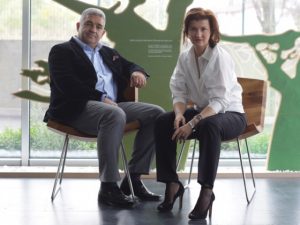Our story is a story of vision and harmony.
THEN…
It was 1992, during an anatomy class, when I approached Siniša and asked:
“Can I work with you?”

At that time, he was the only one at the university who knew how to find work, sell his services, and earn money. It was the year when sanctions were imposed on Serbia, hyperinflation began – banknotes with countless zeros, general chaos, destruction, and hopelessness. War. Many people emigrated. For me, 1992 was the year when everything fell apart. The life of children of socialism had permanently disappeared. What awaited us in the future was unimaginable degradation of values. Unaccustomed to life’s sludge, we had to figure out how to survive and swim in it overnight. We were then students of the Faculty of Applied Arts and Design.
I was studying Interior Design and Furniture, while Siniša was studying Graphic Design. We didn’t want to become part of the misery that was rushing towards us like an apocalypse. At that time, real money was only made by those selling food in kiosks, small businesses, and boutiques. Local shops and kiosks were opening everywhere. And shopping malls, City Passage, Čumićevo Passage, Staklenac… Of course, we always came at the end of the story, after the owner had already spent the money on fixing up the shop, but he also knew he needed a “company” to be able to operate. These were also the beginnings of using computers. We would bring design solutions “made” on the computer, and this would inspire some awe in the owners that “these kids” could indeed do what was needed.
One winter, during some freezing cold, while Siniša and I were kneeling, gluing an advertisement on a fence in Čumićevo Passage, a girl approached us and said she had a company that sold advertising space on buses and asked if we would like to print ads on buses for her. We went to a meeting, got to know each other, and that’s when the work started. We founded Grafix. Back then, advertisements were made according to existing standards, where in a space of 50 cm in height and a few meters in width, you had to fit all the information. These were mostly text-based solutions, with the occasional illustration. Full bus advertising wasn’t done yet. We worked on weekends, in the heat and the cold, and often managed to complete 20-30 buses over a single weekend. Later came the “total design,” as it was called, which was the full painting of a bus. One of the first, if not the first, total designs was for “Duvan,” which we did in three days.
There is also an anecdote related to that “Duvan.” We painted the whole bus orange over two days, Saturday and Sunday. We asked the dispatcher to park it in the farthest corner of the terminal in Karaburma and set up cardboard stencils for the letters we would do on Monday. We reminded the dispatcher before we left that the vehicle was not finished and not to send it into traffic the next day. On Monday morning, we arrived to finish the job, but the bus was nowhere to be found. We checked the entire garage because sometimes they send vehicles for washing or repairs overnight, and drivers often don’t park them in the same spot. We couldn’t find the orange bus anywhere. We went to the dispatcher, and he told us, “Well, it’s on the line.” “How is it on the line when it’s covered in stencils?” “Well, nothing’s happened to it since yesterday, but I’ll send another one and bring this one back.” About an hour later, our bus arrived, with the stencils all torn and blown away. We stood and looked at it in disbelief but said nothing. No one had noticed or cared. All of these experiences were just preparation for the life and work that followed.
When we graduated, we wanted to pursue our profession, but there was no work for us in the old craft-based companies. Marketing agencies didn’t exist in their current form at that time. The ones that did exist mostly “knew it all” and didn’t need professional staff. Back then, a “designer” was anyone who knew how to use CorelDraw, for example. We had ideas for new trends that were coming from the West, revealing to us new products, new technologies, and a new philosophy of business that heralded a new kind of freedom. It was called entrepreneurship. Unneeded by anyone, we became self-organized. At that time, Grafix joined the company “Profi Design.” Three partners, two companies, decided to create a joint legal entity called “Profi Design Group.” We wanted to show the client, with a different approach, that a product could also be high-quality, designed with knowledge and skill. We worked on print preparation, design, organized and supervised printing in the few printing shops in Belgrade at the time, and delivered the final printed product to the client. We also worked on magazine layouts, such as Ekonomska Politika, Intervju, Profil…
Back then, we were among the few who were doing design and preparation on computers. And we did it on PCs. Only Apple Macintosh had the appropriate design software at that time. We had CorelDraw and a huge, self-taught understanding of the program. We had great practice. At that time, the first version of Photoshop on PC was also released. What a leap that was! Anyone who remembers that time knows what a nightmare it was to work on a layout in Venturi Publisher with a bunch of bitmap font sizes on the hard drive. Then Quark came with vector fonts, a revolution in quality and speed. This was also the time when we got our first big jobs. The redesign of the ITM company logo. We approached it professionally, just like we were taught in school. The result was great client satisfaction, and as they saw the quality of our service, they began giving us larger and larger projects. We worked for Gillette, Oral-B, Braun, Nike… Sport Cafe came to us for which we worked on everything from the logo, a menu shaped like sports equipment, to collecting photos, designing, and printing the largest wall graphic at the time, over 12 meters wide and 4.5 meters high, featuring all the most significant Serbian athletes up to that point. After we showed our capabilities there, we began working on interior design and graphic equipping of all Nike stores in Serbia, Bosnia, Montenegro… as well as the AVC (Audio Video Center) chain of stores selling electronics. The era of computer use in everything, including in our industry – commercial graphic design – gave professionals like us a comparative advantage.
In 2 years, Profi Design Group became a good brand. In demand by everyone, we positioned ourselves as a supplier for larger companies. And we succeeded. Working with brands like Nike, Sony, and Coca-Cola introduced us to a field that was open in the market in our country – the field of commercial graphics. First, we developed services, then we bought technology from the developed world. Finally, we created a product. This was a phase of intense innovation. Offering new products to the market. The market began to approve, buying our product, and we moved toward an organization that serviced the production. The opening of the market in the 2000s triggered dynamic activities from new companies, mostly international ones, which brought with them a culture where communication through graphics had an important place. At the same time, professional Serbian companies grew, becoming big buyers of our services. With the founding of Grafix, we wanted to create a comprehensive system for providing production services in the field of commercial graphics based on knowledge, professional organization, and market orientation. We wanted to establish an organization built on family values that would last.
AND NOW…
The next 10 years of Grafix is the story of the transition from an entrepreneurial company to a professional one.

For the next decade, Bigz became synonymous with Grafix for me. In 2001, we leased an entire wing on the second floor of the famous Bauhaus building in Belgrade. We set up our first 1000m² of production space. We introduced the most prestigious printer in the region, Vutek, and thus began the era of high-production, large-format graphics. We had the best print quality, the fastest turnaround, and the best installation. Clients chose us for our quality, knowledge, and professionalism.
At the time, the business that was driving business was marketing. McCann Erickson, Grey, Publicis, Srebrn Tuš, Kreativa, As-Advertising… It was the era of rapid growth for serious marketing. Graphic design flourished during those years of 2002, 2003, and 2004, with the golden years being 2005 and 2006. During this period, we began to materialize the dream of a specialized factory for commercial graphics. We bought land in the industrial zone “Dunavski Venac,” along the Pančevački road. In 2007, we began designing a technologically unique facility, which, on 5,000 m², aimed to capitalize on the vision that Serbia could become a center for commercial graphics. A unique blend of design and technique, 2D and 3D production, under the working title “Center for Idea Development.” At the beginning of our second decade, we experienced the most intense growth to date, reaching up to 30% annually. We worked, hired, expanded, and grew. Our goal was to create a Serbian version of STi, FITCh…
By mid-2008, we were soberly aware that our position as a marginal global player would not help us avoid the crisis that was already raging in America. Seven years of selecting people, writing rules, building the factory, and obtaining ISO certification would be crushed in just two years of crisis. The year 2009 once again showed the face of 1992. Once again, business was collapsing. Once again, we asked how to survive, stay afloat, and keep our people. Once again, we faced losses, reevaluations, and doubts—about ourselves, about Serbia. These years unfolded like this: 2010, with huge losses, a significant decline, and great uncertainty. In 2011, we tried to rise again. In 2012, we achieved growth…
Grafix is a story of 20 full years of work, creating domestic experience, understanding business, learning management, and experiencing both rises and falls. Today, we want to move from a state of sustainable business in our market to a larger playing field and secure the future of Grafix beyond the borders of our country.
Now, we stand at the beginning of our third decade. We’ve seen it all already—twice and three times over. Competition in cartels, corruption, politics in business, business in politics, disloyalty, fraud, betrayals. Much of this could have broken us. Or could it? When you have a foundation in family and a love for creation and the profession, success and recognition of quality come on their own. With the fulfillment of our dream of a factory for commercial graphics and more than 5,000 m² of a Center for Idea Development.
Come, we would be happy to host you.
